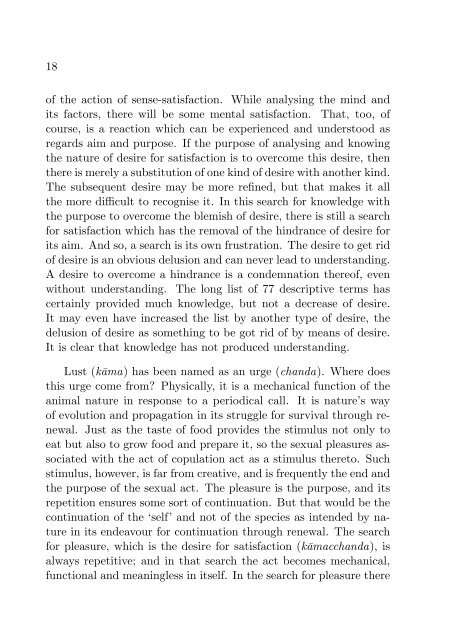Agony and Ecstasy
A comparative study of the five hindrances, together with the five states of concentration or mental absorption.
A comparative study of the five hindrances, together with the five states of concentration or mental absorption.
Create successful ePaper yourself
Turn your PDF publications into a flip-book with our unique Google optimized e-Paper software.
18<br />
of the action of sense-satisfaction. While analysing the mind <strong>and</strong><br />
its factors, there will be some mental satisfaction. That, too, of<br />
course, is a reaction which can be experienced <strong>and</strong> understood as<br />
regards aim <strong>and</strong> purpose. If the purpose of analysing <strong>and</strong> knowing<br />
the nature of desire for satisfaction is to overcome this desire, then<br />
there is merely a substitution of one kind of desire with another kind.<br />
The subsequent desire may be more refined, but that makes it all<br />
the more difficult to recognise it. In this search for knowledge with<br />
the purpose to overcome the blemish of desire, there is still a search<br />
for satisfaction which has the removal of the hindrance of desire for<br />
its aim. And so, a search is its own frustration. The desire to get rid<br />
of desire is an obvious delusion <strong>and</strong> can never lead to underst<strong>and</strong>ing.<br />
A desire to overcome a hindrance is a condemnation thereof, even<br />
without underst<strong>and</strong>ing. The long list of 77 descriptive terms has<br />
certainly provided much knowledge, but not a decrease of desire.<br />
It may even have increased the list by another type of desire, the<br />
delusion of desire as something to be got rid of by means of desire.<br />
It is clear that knowledge has not produced underst<strong>and</strong>ing.<br />
Lust (kāma) has been named as an urge (ch<strong>and</strong>a). Where does<br />
this urge come from? Physically, it is a mechanical function of the<br />
animal nature in response to a periodical call. It is nature’s way<br />
of evolution <strong>and</strong> propagation in its struggle for survival through renewal.<br />
Just as the taste of food provides the stimulus not only to<br />
eat but also to grow food <strong>and</strong> prepare it, so the sexual pleasures associated<br />
with the act of copulation act as a stimulus thereto. Such<br />
stimulus, however, is far from creative, <strong>and</strong> is frequently the end <strong>and</strong><br />
the purpose of the sexual act. The pleasure is the purpose, <strong>and</strong> its<br />
repetition ensures some sort of continuation. But that would be the<br />
continuation of the ‘self’ <strong>and</strong> not of the species as intended by nature<br />
in its endeavour for continuation through renewal. The search<br />
for pleasure, which is the desire for satisfaction (kāmacch<strong>and</strong>a), is<br />
always repetitive; <strong>and</strong> in that search the act becomes mechanical,<br />
functional <strong>and</strong> meaningless in itself. In the search for pleasure there

















